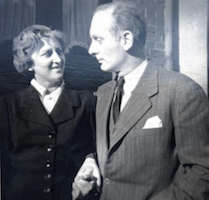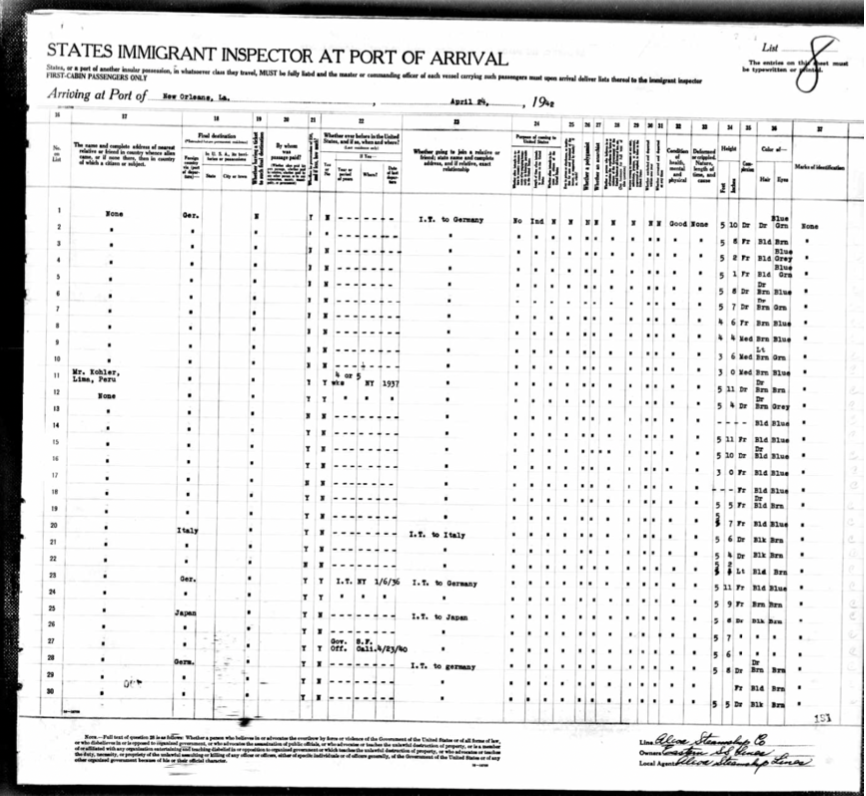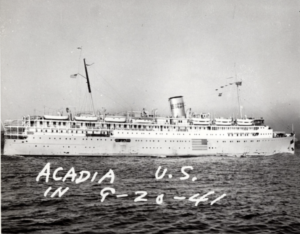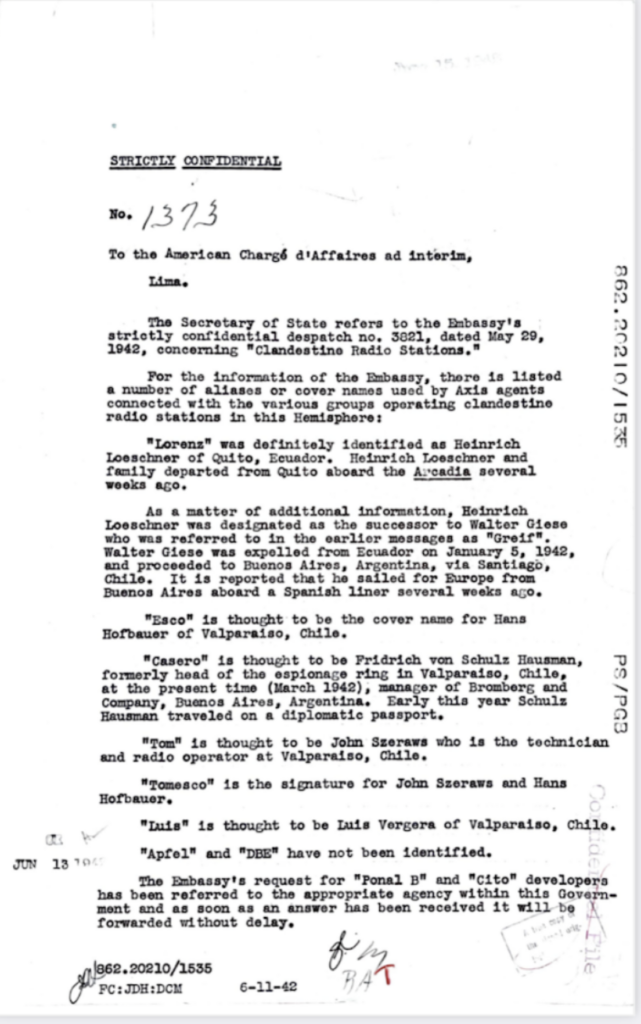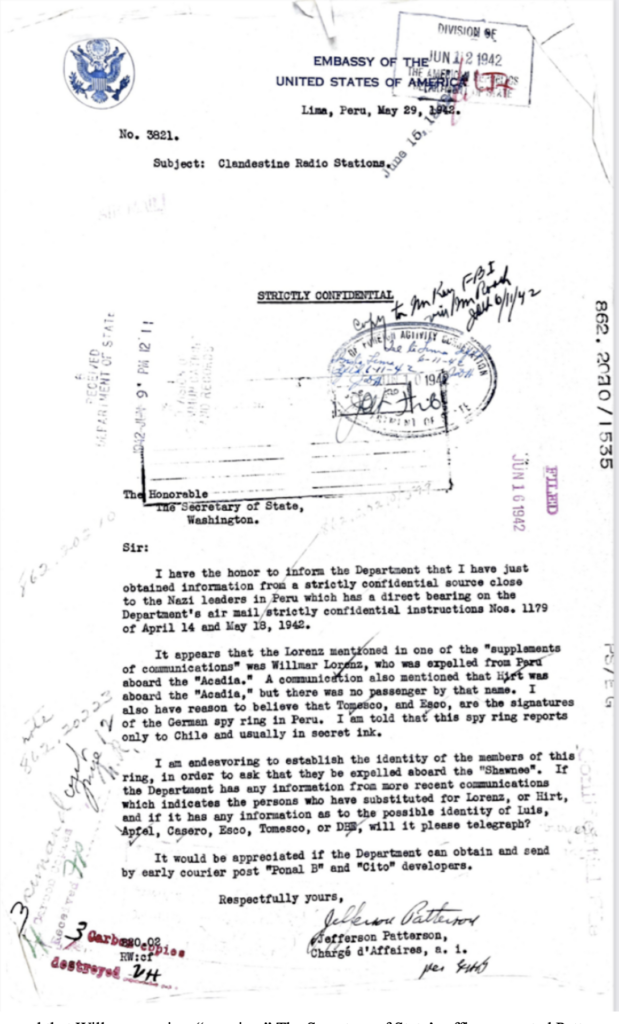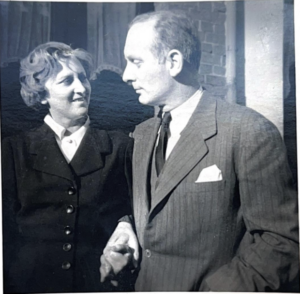Tracking the Lorenz Family Through Franklin Roosevelt’s Internment
by Karl Malek
Early in 1942, while World War II was ravaging the globe, my great-grandfather, my great-grandmother, my grandfather, and my great-aunt were being detained by the Peruvian government in Lima. Being Germans, they were deemed untrustworthy potential Nazis by Peru. Their detentions were part of Franklin Delano Roosevelt’s larger internment program. The United States president cooperated with Latin American republics in the program, bringing their suspected Axis sympathizers to the U.S. My family made up a small part of the 4,058 Germans, 2,264 Japanese, and 287 Italians deported in such a manner.[1] They were shipped as prisoners and treated like criminals. FDR’s government went on to forcibly deport many internees, my ancestors among them, to the active war zone that was 1940s Europe.
the General Artigas
On November 17, 1934, Willmar Lorenz, my great-grandfather, set sail aboard the General Artigas’ “mittelclasse,” or middle class, from the city of Bremen in his native Germany.[2] The 24-year-old was on his way to start a new life in Montevideo, Uruguay. He had accepted a position there with Continental, a German tire manufacturing company. The ship’s manifest listed his profession as “Kaufmann,” or salesman, for the company.[3]
Willmar in Uruguay, 1935
1934 was also the year a German trade delegation first toured South America to establish the economic relationship that helped prompt the Roosevelt’s administration to advocate for Latin American internment. Willmar was entering a geopolitical pot that was about to boil over, but at the time he did not see himself as going abroad to serve the economic interests of his fatherland. With his job and Lore Brandt, his girlfriend, Willmar had every reason to stay in Germany, but he desperately wanted to escape the country. Just a few months earlier, Adolf Hitler rose to power. As a pacifist and a son of a Great War Veteran, Willmar felt uneasy with Hitler’s belligerent rhetoric. In the following years, while Willmar was making a name for himself doing business for Continental throughout South America, Germany was inching towards war. Lore, Willmar’s girlfriend, was in Germany as it was falling apart. Willmar wanted her to join his wonderful new life, so he proposed marriage in a letter and was soon on his way back to Europe for the wedding.
the Munchen
It was not until January 1, 1939, that Lore and Willmar embarked on the Munchen return from Bremen, Germany, to South America, this time, to Callao, Peru. Traveling in a private cabin, Willmar had done well for himself with Continental and was ready to build a family with Lore in Lima.[4] Shielded by the Andes, Lima seemed a world away from Europe’s turmoil, as the rest of 1939 saw the Nazis invade first the Sudetenland and then Poland.
Shielded by the Andes, Lima seemed a world away from Europe’s turmoil, as the rest of 1939 saw the Nazis invade first the Sudetenland and then Poland. By 1942, Willmar and Lore had two babies at home: Heide and Jurgen. Nevertheless, like countless other innocent Germans living throughout Latin America, Willmar found himself on FDR’s Proclaimed List of Certain Blocked Nationals by March 27 of that year.[5]
Special Assistant Lemuel B. Schofield describes plans for “two vessels which will pick up the aliens from the west coast of South America, Peru, Ecuador, and Colombia.” The second of the two vessels would transport “250 officials” and “250 non-official Axis aliens, men, women, and children” to the United States for internment.[7]
Willmar, Lore, and their two kids, Jurgen and Heide, would be among this group of internees. In his Memo, Schofield reported that the ship “will arrive in this country [the United States] about April 27 to April 30.” On April 29, 1942, at 12:01 AM, the Acadia came into port in New Orleans, Louisiana.[8] Each member of the Lorenz family was named on the Acadia’s passenger list with physical and mental information reminiscent of some kind of prisoner description.
“Willmar Lorenz: 31 Years Old. Able to Read and Write. 5 feet, 11 inches tall. 31 Years Old. Fair Complexion. Blond Hair. Blue Eyes. No marks of identification. Elly (Lore) Lorenz* Nee Brandt: 31 Years Old. Able to Read and Write. 5 feet, 10 inches tall. Dark Complexion. Dark Blond Hair. Blue Eyes. No Marks of identification. Heide Lorenz: 2 Years and 6 Months Old. Unable to Read and Write. 3 Feet, 0 Inches tall. Fair Complexion. Blond Hair. Blue Eyes. Juergen (Jurgen) Lorenz: 3 Months Old. Unable to Read and Write. Fair Complexion. Blond Hair. Blue Eyes.”
Conditions on the ship itself reflected the prisoner descriptions. Although it only had space for 200 travelers, the Acadia embarked on its 15-day journey from Callao, Peru, on April 14 with 675 Axis internees on board. Food, water, and showers were scarce.[iv] Upon disembarkation, internees could expect delousing showers and DDT sprays.[v] Leaving the Acadia, German detainees were asked to show visas to enter the United States. None of them had visas, as police had forced them onto the Acadia without providing any. This grievous want of visas gave FDR’s law enforcement the justification to intern the otherwise innocent German passengers.[vi] The President’s policies had stripped them of their property in Peru and made law-breakers of them in a foreign country.
Not only did Franklin Roosevelt put the Lorenz family in this predicament, but his government’s ineptitude also cast its long shadow on my great-grandfather’s character. The President worried about Nazi agents overpowering Latin American governments, but the FBI confirmed the existence of only six German spies in the countries that sent detainees to the United States for internment. One of these confirmed spies was Heinrich Loeschner from Ecuador.[vii] In a June 11, 1942, dispatch response to Jefferson Patterson, Charge d’Affaires in Lima regarding Latin American espionage, the secretary of state’s office wrote about “a number of aliases or cover names used by Axis agents connected with the various groups operating clandestine radio stations in this Hemisphere.” Regarding Loeschner’s alias, the office wrote, “‘Lorenz’ was definitely identified as Heinrich Loeschner of Quito, Ecuador. Heinrich Loeschner and family departed from Quito aboard the Acadia several weeks ago.”
In Patterson’s original May 29 letter to the Secretary of State, he wrote, “It appears that Lorenz mentioned in one of the ‘supplements of communications’ was Willmar Lorenz, who was expelled from Peru aboard the Acadia.”
Patterson assumed that Willmar was in a “spy ring.” The Secretary of State’s office corrected Patterson’s mistake, but the truth did not come out until June 11, two months after Willmar’s first detention. Patterson’s office was so inept as to assign the spy code name “Lorenz” to a man who simply had that last name without conducting any further investigation.
Shortly after the outbreak of World War II, when the FBI was merely gathering intelligence in Latin America, he ordered his officials to specifically find Germans in the region who could be taken as hostages to be exchanged with potential American prisoners of war in Germany.[viii] On March 27, 1942, Lemuel B. Schofield, Special Assistant to the Attorney General, specifically detailed the deportation plans regarding the Acadia’s Passengers, including the Lorenz family:
The other group on board this ‘official vessel’ will consist of 250 non-official Axis aliens, men, women, and children. It is the plan of the State Department to hold them in this country for from two to eight weeks until they can be repatriated.[9]
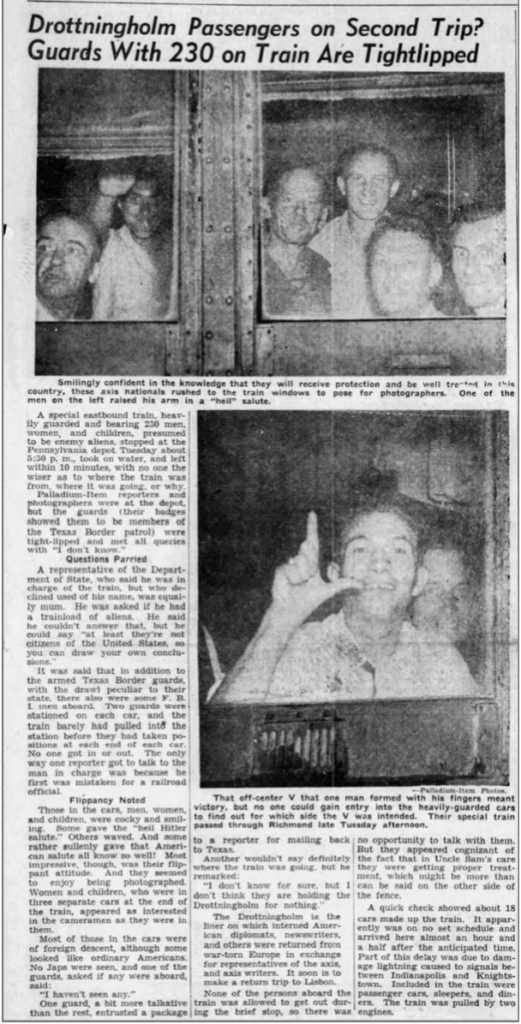 On June 3, 1942, at 6:35 PM, exactly five weeks after arriving in the United States, the Lorenz family set sail from New York on the Drottningholm bound for Europe.[10] The ship reached Lisbon, Portugal, nine days later.[11] The Drottningholm would eventually exchange 932 Germans for 600 Western hemisphere citizens.[ix] A Palladium-Item newspaper article from June 3 describes the German prisoners on trains headed for the Drottningholm by saying, “Some gave the ‘Heil Hitler salute.’ Others waved. And some rather sullenly gave that American salute all know so well!”[12] FDR treated people who gave the “Heil Hitler Salute” and those who gave the “American salute” the same.
On June 3, 1942, at 6:35 PM, exactly five weeks after arriving in the United States, the Lorenz family set sail from New York on the Drottningholm bound for Europe.[10] The ship reached Lisbon, Portugal, nine days later.[11] The Drottningholm would eventually exchange 932 Germans for 600 Western hemisphere citizens.[ix] A Palladium-Item newspaper article from June 3 describes the German prisoners on trains headed for the Drottningholm by saying, “Some gave the ‘Heil Hitler salute.’ Others waved. And some rather sullenly gave that American salute all know so well!”[12] FDR treated people who gave the “Heil Hitler Salute” and those who gave the “American salute” the same.
Forced repatriation put German internees in harm’s way as World War II’s violence ramped up in Germany. As early as May of 1940, the British Royal Air Force started to bomb German industry. A year later, they began indiscriminately bombing cities. On April 8, 1942, when Roosevelt’s agents were making plans to deport families like the Lorenz family to Germany, 272 British planes ravaged the city of Hamburg with bombs. Two and a half months later, when the internees awaited their ocean passage upon the Drottningholm, 898 planes attacked Cologne.[13] Such attacks were commonplace.
Towards the end of the War, Willmar, Lore, and their two kids, Jurgen and Heide, happened to be in Berlin visiting family whom they hadn’t seen for years due to their South American sojourn. Once, when the Allies were subjecting the city to particularly heavy bombardment, Willmar and his father spent a whole night on the roof of their building putting out the fires that kept appearing around them in an effort to spare their family from death by inferno. Their building was the only one left standing in a sea of rubble come morning. Willmar had no desire to be entangled in this gruesome conflict, but FDR’s policies named him, his wife, his toddler, and his infant as potential Nazis who deserved whatever came to them.
Willmar, Lore, Heide, and Jurgen never went back to Peru. They settled in Spain after the war, as my great-grandfather was lucky enough to continue working for Continental Tires, the company that first brought him to Latin America. Jurgen, my grandfather, and Heide, my great-aunt, grew up in small German communities in Barcelona and Madrid.
My great-grandparents actually always maintained that the Americans who interned them treated them quite kindly. For them, the wrongdoing of internment lay more in the policy itself than how it was carried out.
____________________________________________________________________________________________________________
[i] Jan Jarboe Russell, The Train to Crystal City: FDR’s Secret Prisoner Exchange Program and America’s Only Family Internment Camp During World War II (New York: Scribner, 2015), 39.
[ii] Max Paul Friedman, Nazis and Good Neighbors: The United States Campaign against the Germans of Latin America in World War II (Cambridge: Cambridge University Press, 2003), 105.
[iii] Russell, The Train to Crystal City, 39.
[iv] Marilyn Grace Miller, Port of No Return: Enemy Alien Internment in World War II New Orleans (Baton Rouge: Louisiana State University Press, 2021), 63.
[v] Russell, The Train to Crystal City, 39.
[vi] Friedman, Nazis and Good Neighbors, 117.[vii] Friedman, Nazis and Good Neighbors, 66. [viii] Russell, The Train to Crystal City, 28.
[ix] Friedman, Nazis and Good Neighbors, 194.

